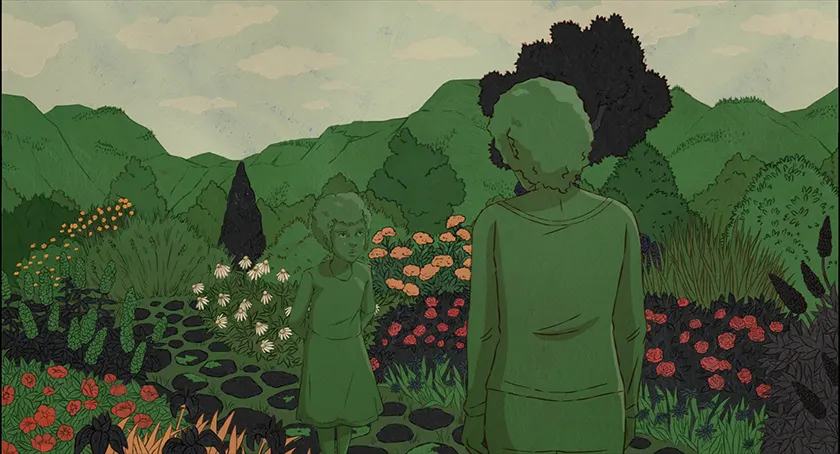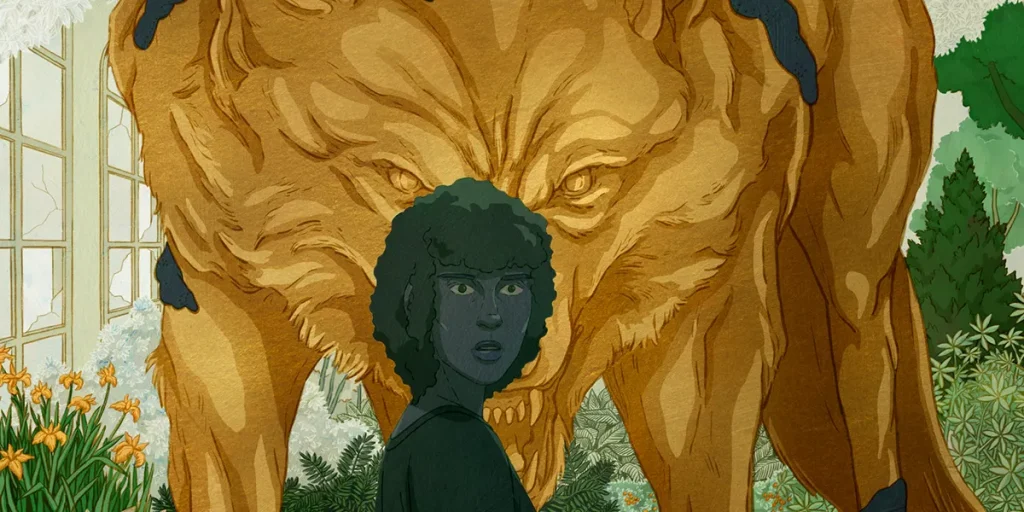Félix Dufour-Laperrière’s Death Does Not Exist is a film that asks us to confront an uncomfortable reality while presenting us with bold and unique visuals.
Writer & Director: Félix Dufour-Laperrière
Genre: Animation
Run Time: 72′
Cannes Premiere: May 15-16, 2025 (Quinzaine des Cinéastes)
Release Date: TBA
Where to watch: Théâtre Croisette, Raimu
“No one can say we just stood by. No one can say we didn’t try,” says one of the characters at the beginning of Death Does Not Exist (La Mort N’Existe Pas). While this feeling is something that many people can probably relate to, the film shows us the traumatic reality of what happens after trying and, perhaps, being afraid of doing something and not standing by after seeing death up close. The film focuses on a group of young activists who start a failed armed attack against a rich family.
But one of them, Hélène, ends up abandoning the others and retreats into the forest, where she will become haunted by Manon, one of the now late activists, who urges her to reconsider her set of beliefs.
With various frames on a beautiful and luxurious mansion, surrounded by nature and filled with classical statues, Death Does Not Exist starts in a peaceful, and almost idyllic, setting. There is nothing in this landscape to suggest the horrors that would happen next. The camera then focuses on a group of unknown people who are moving in the shadows while they plot their next move. As they launch an armed attack on the wealthy landowners we have seen in the opening scene, a young woman named Hélène finds herself hesitating. After fleeing into the forest, the protagonist is haunted by her late companions who lost their lives in the failed attack the audience saw in the opening scene. Hélène’s hallucinations make up the rest of the narrative as the film invites us to join the protagonist in this dream-like state where everything seems possible.
Visually, Death Does Not Exist is one of the most exciting animated films I have seen in the past year or so. From the very beginning, it is immediately clear that the movie will play with colour in a very innovative and fascinating way. With some shots exclusively focused on one colour palette, the visuals guide us through a film whose dream-like narrative may not be as easy to follow without the help of the visual cues. On one side, black and red often remind us of the traumatic attack the protagonist lived through at the beginning of the movie, and on the other, the more earthy green and beige allude to her growing connection with the nature around her.

The main question at the heart of Death Does Not Exist is a fascinating one. We live in a time of stark political divide, when activist groups seem to push for more and more radical forms of protests. But, this film prompts us to question whether organised action, like the protests we see in the film, are such an obvious and natural choice or not. This film is not afraid of asking uncomfortable questions and making the audience face the harsh reality of what an armed attack may look like. As Hélène is overtaken by doubts and worries about her actions, the audience gets a first-row seat to her inner struggle. As the character herself says, “from a distance, it looks easy,” but as we are about to see, it is not so easy from up close.
Despite its memorable lines, Death Does Not Exist has a fundamental writing and storytelling issue. From the very beginning, the audience doesn’t know anything about the rich people Hélène and her friends are attacking, nor the reasons why they are being targeted in the first place. This makes it especially complicated to understand where they are coming from and connect with them on a deeper level. This is also because the movie doesn’t tell us anything about the protagonists either, which ultimately hurts its stakes, as we have little reason to actually root for them. In what seems like a constant tendency to make its story generic and, therefore, adaptable to any setting or context, the film loses its main focus.
Overall, Death Does Not Exist is an ambitious and exciting work. With its bold and unique style, it pushes the boundaries of what we would normally associate with animation filmmaking, reminding us once again that animation is much more than a kids’ genre, as it is often classified by the general public, but rather a stylistic tool to deliver any kind of stories, for any kind of target audience. Despite some difficulties in its storytelling, I am glad to see a movie that makes its mark and is not afraid of making strong choices in its filmmaking.
Death Does Not Exist (La Mort N’Existe Pas): Movie Plot & Recap
Synopsis:
Death Does Not Exist follows Hélène, a young woman who abandons her companions and flees into the nearby forest after a failed armed attack in which she took part in. As the film goes on, the protagonist will find herself questioning her choices and haunting by her companions who lost their life in the opening scene.
Pros:
- The animation style is very unique and memorable, visually contributing to the overall message and atmosphere of the movie.
- The moral dilemma at the heart of the film is particularly relevant and especially relevant to today’s political climate.
Cons:
- The inciting incident remains too general and vague, which ultimately hurts the stakes and urgency of this story.
- The lack of backstories makes it harder for the audience to connect with any of the characters involved in the film and, therefore, care about their stories.
Death Does Not Exist (La Mort N’Existe Pas) premiered at the Cannes Film Festival, in the Quinzaine des Cinéastes, on May 15, 2025 and will be screened again on May 15 at the Théâtre Croisette and on May 16 at Le Raimu. Read our list of 20 movies to watch at the 2025 Cannes Film Festival!

